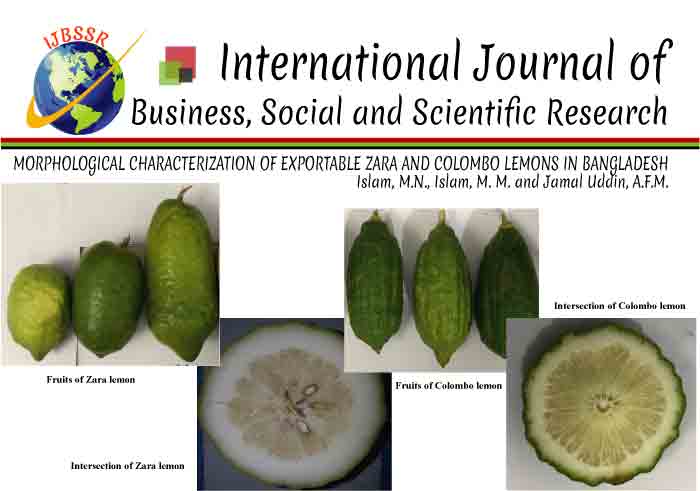MORPHOLOGICAL CHARACTERIZATION OF EXPORTABLE ZARA AND COLOMBO LEMONS IN BANGLADESH

DOI: http://doi.org/10.55706/ijbssr12109
Citrus fruits, particularly Zara and Colombo lemons,
are vital commercial crops in Bangladesh, grown in Sylhet and Narshingdi
districts respectively, and exported to Europe and the Middle East. Despite
their apparent differences, these lemons are often considered the same by
exporters and buyers, causing confusion among growers. Though, both fruits are
marketed internationally under the name Zara Lemon. Notably, Zara lemons are
more susceptible to Canker, while Colombo lemons are more prone to Scab. This study
aims to clearly identify and differentiate these lemons to improve
horticultural and business practices. Experiments were conducted in Joyientapur
and Gowainghat Upazilas (Sylhet district) for Zara Lemons, and in Belabo and
Shibpur Upazilas (Narshingdi district) for Colombo Lemons, focusing on
morphological features such as trunks, branches, leaves, flowers, and internal
structures during January to June 2021. The findings revealed distinct differences: Zara
lemons had an average height of 3.66±0.45m, stem diameter of 27.94±0.19 cm,
canopy radius of 12.19±0.51 m, and first branch height at 22.86±0.21 cm, with
7.50±0.47 branches per plant. In contrast, Colombo lemons exhibited an average
height of 3.04±0.11m, stem diameter of 24.13±0.25 cm, canopy radius of
9.14±0.29 m, and first branch height at 114.30±0.45 cm, with 4.25±0.23 branches
per plant. Zara lemons typically had 4 petals per flower, occasionally 5, and
their edible skin averaged 211.00±82.60g, compared to Colombo’s 118.00±35.81g.
These results confirm that Zara and Colombo lemons are morphologically
distinct, necessitating accurate identification for optimal management.

